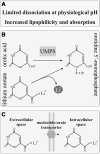Lithium orotate: A superior option for lithium therapy?
- PMID: 34196467
- PMCID: PMC8413749
- DOI: 10.1002/brb3.2262
Lithium orotate: A superior option for lithium therapy?
Abstract
Bipolar disorder (BD) poses a significant public health concern, with roughly one-quarter of sufferers attempting suicide. BD is characterized by manic and depressive mood cycles, the recurrence of which can be effectively curtailed through lithium therapy. Unfortunately, the most frequently employed lithium salt, lithium carbonate (Li2 CO3 ), is associated with a host of adverse health outcomes following chronic use: these unwanted effects range from relatively minor inconveniences (e.g., polydipsia and polyuria) to potentially major complications (e.g., hypothyroidism and/or renal impairment). As these undesirable effects can limit patient compliance, an alternative lithium compound with a lesser toxicity profile would dramatically improve treatment efficacy and outcomes. Lithium orotate (LiC5 H3 N2 O4 ; henceforth referred to as LiOr), a compound largely abandoned since the late 1970s, may represent such an alternative. LiOr is proposed to cross the blood-brain barrier and enter cells more readily than Li2 CO3 , which will theoretically allow for reduced dosage requirements and ameliorated toxicity concerns. This review addresses the controversial history of LiOr, complete with discussions of experimental and clinical efficacy, putative mechanisms of action, adverse effects, and its potential future in therapy.
Keywords: Lithium Toxicity; Maintenance Therapy; Mania; Mood Stabilizer; Pharmacokinetics; increased therapeutic window.
© 2021 The Authors. Brain and Behavior published by Wiley Periodicals LLC.
Conflict of interest statement
The authors have no conflict of interest to declare.
Figures




References
-
- Allison, J. H., Blisner, M. E., Holland, W. H., Hipps, P. P., & Sherman, W. R. (1976). Increased brain myo‐inositol 1‐phosphate in lithium‐treated rats. Biochemical and Biophysical Research Communications, 71(2), 664–670. - PubMed
-
- Allison, J. H., & Stewart, M. A. (1971). Reduced brain inositol in lithium‐treated rats. Nature New Biology, 233(43), 267–268. - PubMed
-
- Aonuma, S., Hama, T., Tamaki, N., & Okumura, H. (1969). Orotate as a beta‐alanine donor for anserine and carnosine biosynthesis, and effects of actinomycin D and azauracil on their pathway. Journal of Biochemistry, 66(2), 123–132. - PubMed
-
- Association AP . (2013). Diagnostic and statistical manual of mental disorders (5th ed.). American Psychiatric Association.
Publication types
MeSH terms
Substances
LinkOut - more resources
Full Text Sources
Medical
Research Materials

